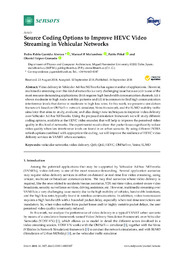Por favor, use este identificador para citar o enlazar este ítem:
https://hdl.handle.net/11000/31381Registro completo de metadatos
| Campo DC | Valor | Lengua/Idioma |
|---|---|---|
| dc.contributor.author | Garrido Abenza, Pedro Pablo | - |
| dc.contributor.author | Perez Malumbres, Manuel | - |
| dc.contributor.author | Piñol, Pablo | - |
| dc.contributor.author | López Granado, Otoniel Mario | - |
| dc.contributor.other | Departamentos de la UMH::Ingeniería de Computadores | es_ES |
| dc.date.accessioned | 2024-02-09T12:30:02Z | - |
| dc.date.available | 2024-02-09T12:30:02Z | - |
| dc.date.created | 2018-09 | - |
| dc.identifier.citation | Sensors Volume 18 Issue 9 (2018) | es_ES |
| dc.identifier.issn | 1424-8220 | - |
| dc.identifier.uri | https://hdl.handle.net/11000/31381 | - |
| dc.description.abstract | Video delivery in Vehicular Ad-hoc NETworks has a great number of applications. However, multimedia streaming over this kind of networks is a very challenging issue because (a) it is one of the most resource-demanding applications; (b) it requires high bandwidth communication channels; (c) it shows moderate to high node mobility patterns and (d) it is common to find high communication interference levels that derive in moderate to high loss rates. In this work, we present a simulation framework based on OMNeT++ network simulator, Veins framework, and the SUMO mobility traffic simulator that aims to study, evaluate, and also design new techniques to improve video delivery over Vehicular Ad-hoc NETworks. Using the proposed simulation framework we will study different coding options, available at the HEVC video encoder, that will help to improve the perceived video quality in this kind of networks. The experimental results show that packet losses significantly reduce video quality when low interference levels are found in an urban scenario. By using different INTRA refresh options combined with appropriate tile coding, we will improve the resilience of HEVC video delivery services in VANET urban scenarios. | es_ES |
| dc.format | application/pdf | es_ES |
| dc.format.extent | 18 | es_ES |
| dc.language.iso | eng | es_ES |
| dc.publisher | MDPI | es_ES |
| dc.rights | info:eu-repo/semantics/openAccess | es_ES |
| dc.rights | Attribution-NonCommercial-NoDerivatives 4.0 Internacional | * |
| dc.rights.uri | http://creativecommons.org/licenses/by-nc-nd/4.0/ | * |
| dc.subject | vehicular networks | es_ES |
| dc.subject | video delivery | es_ES |
| dc.subject | QoS | es_ES |
| dc.subject | QoE | es_ES |
| dc.subject | HEVC | es_ES |
| dc.subject | OMNeT++ | es_ES |
| dc.subject | Veins | es_ES |
| dc.subject | SUMO | es_ES |
| dc.subject.other | CDU::6 - Ciencias aplicadas::62 - Ingeniería. Tecnología | es_ES |
| dc.title | Source Coding Options to Improve HEVC Video Streaming in Vehicular Networks | es_ES |
| dc.type | info:eu-repo/semantics/article | es_ES |
| dc.relation.publisherversion | https://doi.org/10.3390/s18093107 | es_ES |

Ver/Abrir:
01_sensors-18-03107-v2 (1).pdf
645,14 kB
Adobe PDF
Compartir:
 La licencia se describe como: Atribución-NonComercial-NoDerivada 4.0 Internacional.
La licencia se describe como: Atribución-NonComercial-NoDerivada 4.0 Internacional.
.png)